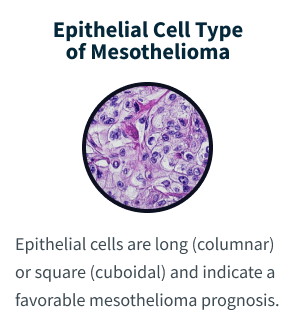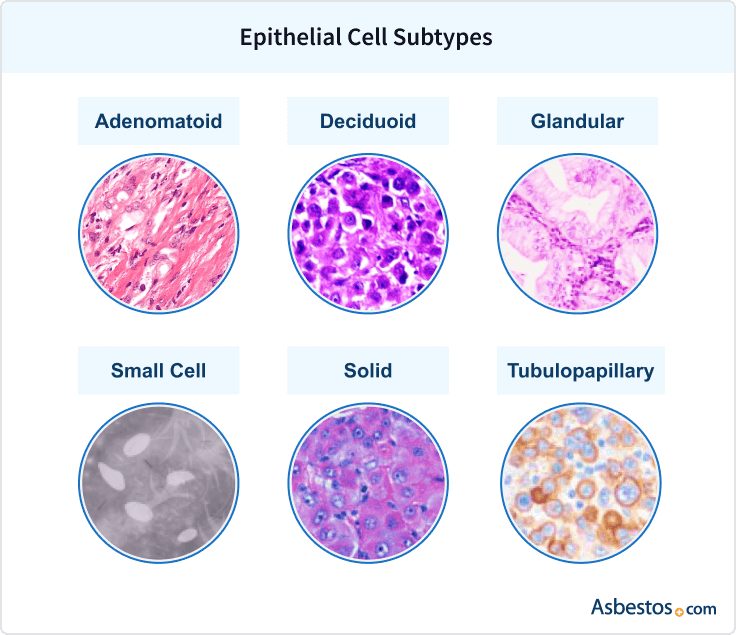Epithelioid Mesothelioma
Epithelioid mesothelioma is asbestos cancer involving epithelial cells. Doctors diagnose 1,500 to 2,100 epithelial cases annually, representing 50%-70% of mesothelioma diagnoses. The 5-year survival rate is 12%, with people living an average of 200 days longer than those with other cell types.
Written byKaren Selby, RN•Edited ByWalter Pacheco•Medically Reviewed ByDr. Jacques Fontaine
Asbestos.com is the nation’smost trustedmesothelioma resource
The Mesothelioma Center at Asbestos.com has provided patients and their loved ones the most updated and reliable information on mesothelioma and asbestos exposure since 2006.
Our team of Patient Advocates includes a medical doctor, a registered nurse, health services administrators, veterans, VA-accredited Claims Agents, an oncology patient navigator and hospice care expert. Their combined expertise means we help any mesothelioma patient or loved one through every step of their cancer journey.
More than 30 contributors, including mesothelioma doctors, survivors, health care professionals and other experts, have peer-reviewed our website and written unique research-driven articles to ensure you get the highest-quality medical and health information.
About The Mesothelioma Center at Asbestos.com
- Assisting mesothelioma patients and their loved ones since 2006.
- Helps more than 50% of mesothelioma patients diagnosed annually in the U.S.
- A+ rating from the Better Business Bureau.
- 5-star reviewed mesothelioma and support organization.
Testimonials
My family has only the highest compliment for the assistance and support that we received from The Mesothelioma Center. This is a staff of compassionate and knowledgeable individuals who respect what your family is experiencing and who go the extra mile to make an unfortunate diagnosis less stressful. Information and assistance were provided by The Mesothelioma Center at no cost to our family.LashawnMesothelioma patient’s daughter
How to Cite Asbestos.com’s Article
APA
Selby, K. (2023, September 19).Epithelioid Mesothelioma.Asbestos.com. Retrieved October 11, 2023, from //www.magnakarsa.com/mesothelioma/malignant/epithelial/
MLA
Selby, Karen. "Epithelioid Mesothelioma."Asbestos.com2023年9月19日,//www.magnakarsa.com/mesothelioma/malignant/epithelial/.
Chicago
Selby, Karen. "Epithelioid Mesothelioma." Asbestos.com. Last modified September 19, 2023. //www.magnakarsa.com/mesothelioma/malignant/epithelial/.
What Is Epithelial Mesothelioma?
Epithelial, or epithelioid,mesothelioma canceris the most common of this cancer’s threecell types. The epithelium is a protective layer of cells that line the outer surface of organs, blood vessels and cavities. Asbestos fibers irritate these cells and are the primary cause of epithelioid mesothelioma.
- About 54% ofpleural mesotheliomatumors contain epithelial cells.
- Doctors diagnose 1,500 to 2,100 epithelioid mesothelioma patients annually.
- Epithelial mesothelioma accounts for 50% to 70% of all cases.
- Epithelioid cells comprise about 75% ofperitoneal mesotheliomatumors.
- The epithelioid type has the best prognosis of alltypes of mesothelioma.
Epithelial mesothelioma can develop in the lining of the lungs (pleural), abdomen (peritoneal), heart (pericardial) or testes (testicular). Patients with the epithelial tumor cell type live about six months longer than those withbiphasicorsarcomatoidcell types. Epithelial cells respond better than others to aggressive treatment.
“The epithelial type does tend to be more favorable,” mesothelioma specialist Dr. Andrea Wolf of Mount Sinai Hospital told The Mesothelioma Center at Asbestos.com. “It does tend to respond to chemotherapy a little more easily.”
What Causes Epithelial Mesothelioma?
The primaryrisk factorandcause of epithelioid mesotheliomais the same as other cell types of mesothelioma: asbestos exposure. Inhalation or ingestion of asbestos fibers causes tissue inflammation and DNA damage, leading to cancer development decades later.

Most people diagnosed with epithelioid mesothelioma worked with asbestos products long before their diagnosis. All mesothelioma cell types have a latency period of 20 to 60 years. The first symptoms may not show up for decades after the initial asbestos exposure.
The Patient Advocates at The Mesothelioma Center say many newly diagnosed patients who call to ask questions about their mesothelioma diagnosis typically do not know their cell type. It’s important to ask your doctor about cell type because it will help you understand your symptoms, treatment and prognosis.

Epithelioid Mesothelioma Symptoms
Epithelioidmesothelioma symptomsoften include cough, shortness of breath and lack of appetite. As the disease progresses, more severe symptoms may surface. Many symptoms depend on tumor location and size.
- Abdominal pain or bloating
- Bowel or bladder changes
- Chest tightness or pain
- Cough, hoarseness or difficulty swallowing
- Difficulty breathing
- Fever or night sweats
- Fluid buildup in the chest or abdomen (effusion)
- Nausea, vomiting or diarrhea
- Unexplained weight loss
Mesothelioma symptoms are the same, no matter the cell type. A person with epithelial tumors will have symptoms similar to those with the sarcomatoid type. However, the cell type affects which treatments are most helpful. Talk to your doctor if you experience any of these symptoms.

How Is Epithelioid Mesothelioma Diagnosed?
Atissue biopsyis the only way to diagnose epithelial mesothelioma. This procedure samples the lung tissue to confirm the cell type under a microscope. Epithelial mesothelioma cells clump together in groups and do not tend to travel. These cells are less likely to spread to other areas of the body.
- Blood testsare not helpful for diagnosis, but they can track treatment progress.
- Diagnosing epithelioid mesotheliomarequires imaging tests and a biopsy.
- Imaging scanscan show lung abnormalities but alone cannot diagnose cancer.
“Epithelial subtype mesothelioma describes the type of cells the pathologist is seeing under the microscope when they look at a patient’s tumor,”Dr. Andrea Wolfnoted.
Epithelial mesothelioma cells can take on a variety of shapes and sizes. These include cuboid (square), columnar (long) or squamous (flat). The cells also carry DNA within a visible nucleus.
Understanding Your Pathology Report
After a biopsy, the pathologist will create a report for your physician. This report includes cell distribution and a final diagnosis. The pathology report describes thetypes of mesothelioma cellsfound in a patient’s tumors. The cell type informs your doctor how your cancer might progress. It also determines which treatment options may be best.
“When I first speak with a patient, I ask about their diagnosis and cell type,” Patient AdvocateDanielle DiPietronoted. “If they say they don’t know, I explain how to find it on their pathology report. I also explain the three cell types and their meaning for their mesothelioma journey.”
Epithelial Cell Subtypes
Pathologists use chemical stains to revealimmunohistochemical markersand identify subtypes. If you have a specific subtype, it could influence your treatment options ormesothelioma prognosis. Rare subtypes could lead to amisdiagnosis. Some epithelioid cell subtypes, such as adenomatoid, are associated with better survival. Epithelial subtypes include:
- Adenomatoid.Also known as the microglandular cell type, it accounts for 6% of pleural cases. The peritoneal form behaves like benign lesions and responds well to treatment.
- Deciduoid.Doctors have diagnosed fewer than 50 cases of this rare subtype. It can be mistaken for other cancers, including squamous cell lung cancer.
- Glandular.Glandular tumors often develop in the pleura and have gland-like (acinar) patterns. These cells mimic adenocarcinoma that has spread to the pleura.
- Small Cell.Small cell mesothelioma does not display the stream, ribbon or rosette patterns of small cell lung cancer. This cell type has a survival rate of about eight months.
- Solid.Well-differentiated solid cells group in nests, cords or sheets and look like benign hyperplasia. Poorly differentiated cells may look like large cell carcinoma or lymphoma.
- Tubulopapillary.This common epithelial subtype can appear as adenocarcinoma in the pleura. It is not the same as benign well-differentiated papillary mesothelioma.

“When I speak with a patient who is hesitant to have a biopsy, which is rare, I explain that knowing the cell type is imperative when assessing treatment options,” DiPietro said.
Talk to yourmesothelioma doctorabout your cell type, cancer stage and tumor grade (speed of tumor growth). Ask how these factors affect your treatment plan and prognosis.
What Is the Survival Rate for Epithelial Mesothelioma?
The 5-yearsurvival ratefor epithelioid pleural mesothelioma is 12%. A peritoneal mesothelioma study showed a median survival of 55 months for patients with epithelioid cells. By comparison, patients with sarcomatoid or biphasic cells had a median survival of seven to 13 months.
The survival rate for epithelial patients is overall significantly longer. Epithelial cell type is the best mesothelioma cell type to have. This patient will have more options, such as surgery, and is more likely to respond to treatment.Karen SelbyPatient Advocate
Epithelioid patients live 200 days longer on average than patients with other cell types. Thelife expectancyof epithelial malignant mesothelioma patients is 18 months. The overall survival of all cell types drops when the diseasemetastasizesor spreads.
How Is Epithelioid Mesothelioma Treated?
Doctors treat early-stage epithelioid mesothelioma aggressively with surgery, chemotherapy and radiation therapy. Late-stage cases respond better topalliative carewith immunotherapy, chemotherapy and Tumor Treating Fields therapy. A combination of approaches is often the most effective method.
- Chemotherapy.Chemotherapycan triple the mesothelioma survival rate.
- Immunotherapy.Immunotherapy可以扩展生存为许多患者18个月吗.
- Radiation.Radiation therapyhelps manage symptoms and prevent local recurrence.
- Surgery.Surgeryextends survival an average of two years or five years after HIPEC.
Yourtreatmentwill depend on the cancer stage, tumor extent and overall health. Of the three cell types, epithelial mesothelioma responds best to treatment.
Consider a second opinion at atop cancer center. The specialists at these centers have the experience to diagnose and treat epithelioid mesothelioma effectively. They can offerclinical trialsand multidisciplinary treatment to control the disease with different therapies.
Common Questions About Epithelioid Mesothelioma
- Where can I get treatment for epithelial cell mesothelioma?
-
Look for mesothelioma specialists with years of experience treating pleural and peritoneal mesothelioma. Most oncologists need to be trained to treat epithelioid mesothelioma. Our Patient Advocates can help you find a top doctor who treats epithelial mesothelioma.
- Can epithelioid mesothelioma be prevented?
-
Asbestos exposure is the primary cause of mesothelioma. Avoiding it is the best way to prevent mesothelioma. If you have a history of asbestos exposure, talk to your doctor about cancer screenings, which may aid in an early diagnosis.
- Is epithelioid mesothelioma curable?
-
不幸的是,上皮样的间皮瘤没有坏蛋e. But patients with the epithelioid cell type have the most mesothelioma treatment options. This cell type responds the best to all forms of treatment.
- Is there any ongoing research on epithelioid mesothelioma?
-
研究人员不断寻找mesothelioma patients with the epithelioid cell type for clinical trials. They seek out these participants because epithelioid is the disease’s most common cell type. Studying epithelioid patients lets researchers know how a drug or therapy will affect most patients diagnosed with mesothelioma.
- 上皮细胞变成间皮瘤如何?
-
Epithelial cells line the airways and are constantly exposed to substances from the air you breathe. One of the main causes of mesothelioma is asbestos exposure. When you inhale asbestos fibers, they can become trapped in the lungs and induce inflammation. Long-term inflammation can lead to mutations in epithelial cells, eventually giving rise to cancer.










